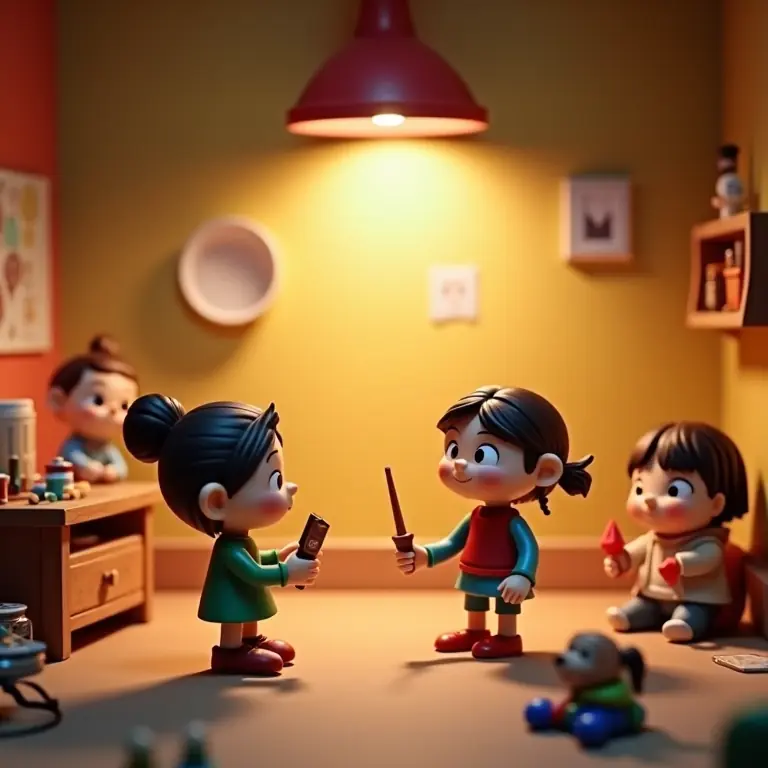Sculpt Simple Stories: A Friendly Guide to Basic Stop-Motion Animation
Ever watched a claymation film and wondered how those objects seem to *move* on their own? It’s not magic, it’s stop-motion animation! And guess what? You can do it too! This guide will walk you through the basics of stop-motion, from gathering your materials to breathing life into your little creations. Don’t worry if you’ve never tried animation before – we’ll start with the very fundamentals and build from there. We’ll focus on a simple, accessible approach, perfect for beginners.
What *is* Stop-Motion Animation?
At its heart, stop-motion is a filmmaking technique where you physically manipulate objects in small increments between individually photographed frames. When you play these frames back rapidly, it creates the illusion of movement. Think of it like flipping through a flipbook – each drawing is slightly different, and when flipped quickly, it looks like the image is moving. Stop-motion relies on patience and precision, but the results can be incredibly rewarding. It’s a fantastic way to tell stories, express creativity, and learn about filmmaking principles.
Gathering Your Supplies: The Essential Toolkit
The beauty of stop-motion is that you don’t need expensive equipment to get started. Here’s a breakdown of what you’ll need:
- A Camera: A smartphone camera works perfectly well! Anything that can take clear, still photos is suitable. A DSLR or mirrorless camera offers more control, but isn’t necessary for beginners.
- A Tripod: This is crucial. You need to keep your camera perfectly still between each frame. Even a slight shift will make your animation look shaky. A small, inexpensive tabletop tripod is a great starting point.
- Animation Software (or App): Several options exist. Some popular choices include:
- Stop Motion Studio (iOS & Android): User-friendly and feature-rich, great for beginners.
- Dragonframe (Paid): Industry standard, offering advanced features.
- iMovie (Mac): Can be used for basic stop-motion, although less specialized.
- Modeling Material: This is where your creativity comes in!
- Plasticine Clay: Easy to mold and doesn’t dry out. A classic choice.
- Polymer Clay: Requires baking to harden, allowing for more permanent creations.
- Play-Doh: Fun and readily available, but can dry out quickly.
- LEGOs: Perfect for blocky, dynamic animations.
- Paper Cutouts: A simple and effective option for 2D animation.
- Everyday Objects: Toys, utensils, anything you can manipulate!
- A Stable Surface: A table or floor will work. Make sure it’s not prone to vibrations.
- Lighting: Consistent lighting is essential. Avoid relying on natural light, as it changes throughout the day. Two or three desk lamps will do the trick. Consider using daylight-balanced bulbs for consistent color.
- Optional Extras:
- Backdrops: Paper, fabric, or painted boards to create a scene.
- Props: Small objects to add detail and interest.
- Armature Wire: For creating posable characters (more advanced).
Planning Your Story: From Idea to Storyboard
Before you start moving anything, it’s important to have a plan. Even a simple animation benefits from some pre-production. Here’s how to approach it:
- Brainstorm Ideas: What story do you want to tell? Start small. A character walking across the screen, a ball bouncing, or a simple transformation are good starting points.
- Write a Basic Script (Optional): For more complex animations, a script can help you stay organized.
- Create a Storyboard: This is a visual outline of your animation. Draw a series of sketches representing key moments in your story. Under each sketch, write a brief description of what’s happening. A storyboard helps you visualize the flow of the animation and identify potential problems before you start shooting.
- Consider the Length: Remember that stop-motion is time-consuming. A short animation (5-10 seconds) is a good goal for your first project.
Thinking about the visual aspects of your animation is important too. Do you want a bright and cheerful aesthetic, or something darker and more mysterious? Consider color palettes and the overall mood you want to create. If you’re feeling creatively stuck, perhaps a relaxing activity like crafting cozy candles could spark some inspiration!
The Animation Process: Frame by Frame
Now for the fun part! Here’s a step-by-step guide to animating:
- Set Up Your Scene: Place your backdrop, props, and characters on your stable surface.
- Position Your Camera: Secure your camera on the tripod and frame your shot.
- Take the First Photo: Make sure your scene is well-lit and in focus.
- Move Your Object: Make a *small* adjustment to your character or object. The smaller the movement, the smoother the animation will be.
- Take Another Photo: Capture the new position.
- Repeat Steps 4 & 5: Continue moving your object and taking photos, frame by frame. This is the core of stop-motion animation.
- Playback: Periodically playback your animation in your chosen software to see how it’s progressing.
Frame Rate: The frame rate determines how many frames are displayed per second. A higher frame rate results in smoother animation, but requires more frames. Here are some common frame rates:
- 12 fps: A slightly choppy, but charming look. Good for beginners.
- 24 fps: Standard film frame rate. Creates very smooth animation.
- 30 fps: Common for video. Also creates smooth animation.
For your first animation, starting with 12 fps is a good idea. This will reduce the number of photos you need to take and make the process less daunting.
Tips for Smooth Animation
- Small Movements: Emphasize this! The key to smooth animation is making tiny, incremental changes.
- Consistent Lighting: Avoid flickering or shadows.
- Stable Camera: Use a tripod!
- Anticipation & Follow Through: Just like in live-action animation, anticipate movements (e.g., a character bending their knees before jumping) and include follow-through (e.g., hair or clothes continuing to move after the character stops).
- Overlapping Action: Different parts of a character should move at slightly different times. This adds realism and depth.
- Patience: Stop-motion takes time and effort. Don’t get discouraged if it doesn’t look perfect right away.
Adding Sound and Music
Once you’ve finished animating, you can add sound effects, music, and even dialogue to bring your story to life. Most animation software allows you to import audio files.

- Sound Effects: Add sounds to enhance the action (e.g., footsteps, crashes, whooshes).
- Music: Choose music that complements the mood and pace of your animation.
- Dialogue: If your animation includes characters speaking, you’ll need to record their voices.
There are many free sound effect libraries available online. Be mindful of copyright when using music.
Post-Production: Editing and Refining
After adding sound, you might want to do some basic editing to refine your animation. This could include:
- Cutting Unnecessary Frames: Remove any frames that don’t contribute to the story.
- Adjusting Timing: Speed up or slow down certain sections of the animation.
- Color Correction: Adjust the colors to create a consistent look.
- Adding Titles and Credits: Give your animation a professional finish.
Beyond the Basics: Exploring Advanced Techniques
Once you’ve mastered the fundamentals, you can explore more advanced techniques, such as:
- Armature Animation: Using wire skeletons to create more complex and poseable characters.
- Rotoscoping: Tracing over live-action footage to create animated sequences.
- Matte Painting: Creating realistic backgrounds using painted or photographic elements.
- Visual Effects: Adding digital effects to enhance your animation.
Resources and Inspiration
Here are some resources to help you on your stop-motion journey:
- YouTube Channels: Search for “stop motion tutorial” on YouTube for a wealth of helpful videos.
- Online Forums: Connect with other stop-motion animators and share your work.
- Stop Motion Animation Books: Numerous books are available covering all aspects of stop-motion.
- Inspirational Films: Watch classic stop-motion films like *Wallace & Gromit*, *Coraline*, and *The Nightmare Before Christmas* for inspiration.
Don’t be afraid to experiment and have fun! Stop-motion animation is a rewarding and creative process. And while you’re nurturing your creativity, remember to take care of your other passions! Perhaps you also enjoy maintaining your vintage vinyl collection – a guide to reviving your records might be a welcome distraction.
Practice Exercises: Get Your Hands Moving!
Here are a few exercises to get you started:
- Bouncing Ball: A classic exercise. Focus on the arc of the ball and the timing of the bounces.
- Walking Cycle: Create a simple walking animation for a character.
- Transformation: Animate an object changing shape or form.
- Object Interaction: Animate two objects interacting with each other.
Here’s a helpful video to get you started with some animation basics:
Building Your Personal Brand Through Storytelling
Creating stop-motion animation can also be a fantastic way to express yourself and build your personal brand. The unique style and storytelling ability demonstrated through animation can set you apart. Consider how your animation projects reflect your values, interests, and personality. If you’re looking to further develop your personal brand, exploring resources on crafting your personal elevator pitch can be incredibly beneficial.
So, what are you waiting for? Gather your supplies, unleash your imagination, and start sculpting simple stories! Happy animating!


Discussion about this post